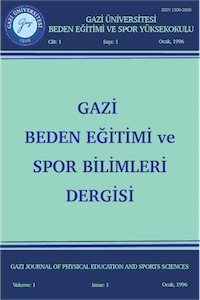Abstract
Effects of basketball on the bone mineral density (KMY) of adolescent and young adult female (BB) and male (EB) basketball players were evaluated. The age distribution, body mass index (VKE), duration of exercise (for how many years, for how many weeks per year, for how many days per week and for how many hours per day), food consumption and living habits of the BB and EB groups were compared to the KMY. The KMY was measured with a dual energy x-ray absorbtiometer (QDR - 4500, Hologic Inc.). The spinal column (Li-La) and the right hip region (femoral neck, trochanteric region, intertrochanteric area, Ward triangle and total femur) were evaluated in the anterior-posterior direction. The "WHO Osteoporosis Project" questionnaire established for case control studies in 1993 was modified and applied to the athletes to assess their food consumption, living habits and menstrual status of the female players. The results indicate that there is a positive correlation between the age, VKE and duration of exercise and KMYin both of the groups. The increase of KMY compared to the increase of the VKE in the EH group was more significant than that of the BB group, especially at the hip region. The Eli group training for less than 450 h per year had higher values, specially around the hip region, than the BB group. However, the KMY values of the EB and BB groups training for more than 450 h per year had similar values. The KMY values of the BB group trained less than 2000 h in total were tower than that of the EB group. Both the EB and BB groups trained more than 2000 h in total had similar KMY values. As the ages of both of the groups were relatively young, smoking and alcohol consumption was not recorded. Menstrual irregularities and painful menstruation was a common finding in the BB group, however, they did not correlate with the KMY values.
References
- Cohen, B., P. J. Millett, B. Mist, M. A. Laskey and N. Rushton. Effect of exercise training program on bone mineral density in novice college rowers. Br. J. Sports Med. 29: 85-88, 1995.
- Dalsky, G. P. Exercise: its effect on bone mineral content. Clin. Gynecol. 30 : 820 - 831, 1987.
- Friedlander, A. L . , H. K. Genant, S. Sadovvsky, N. N. B yl , and C. C. Gluer. A two-year program of aerobics and weight training enhances bone mineral density of young women. J. Bone Miner. Res. 10 : 574 - 585,1995.
- Fruth, S. J. and T. W. Worrell. Factors associated with menstrual irregularities and decreased bone mineral density in female athletes. J. Orthop. Sports Phys. Ther. 22: 26-38,1995.
- Garrow, J.S. Treat obesity seriously. Edinburgh, Churchill Livingstone, 1981, pp. 3.
Abstract
Ergenlik çağlarında basketbolün kemik mineral yoğunluğuna (KMY) etkisi bayan (BB) ve erkek basketbolçularda (EB) karşılaştırmalı olarak incelendi. KMY Ankara Düzen Laboratuvarında ölçüldü. Ölçümlerde Hologic QDR 4500 kemik densitometresi kullanıldı. L I - I A omurlar ve sağ kalça bölgesi (femur boynu, trokanter bölgesi, intertrokanterik alan, Ward üçgeni ve femur totali) ön-arka yönde incelendi. Kemik mineral yoğunluğunun yanısıra sporcuların vücut kitle endeksleri (VKE) ve egzersiz süreleri (kaç yıldır, yılda kaç hafta, haftada kaç gün ve antrenmanda ortalama kaç saat egzersiz yaptığı) kaydedildi. Dünya Sağlık Örgütü'nün (WHO) 1993 yılında osteoporoz projesinde uyguladığı sorgulama formu geliştirilerek sporcu kırın KMY ile ilişkili yiyecek tüketimleri, alışkanlıkları ve bayanların adet bilgileri sorgulandı. Vücut kitle endeksinin BB ve EB gruplarında 20.5 ±1.8 ve20.4 ±2.3 olduğu belirlendi. Her iki grupta da yaşın, VKE ve egzersiz süresinin artmasıyla KMY'nun arttığı saptandı. Aynı yaş EB ve BB gruplarının omurga bölgesinde KMY'nun belirgin bir fark göstermediği ancak kalça çevresinde EB grubunda BB grubuna oranla daha yüksek olduğu saptandı. Egzersiz süreleriyle KMY arasındaki ilişki incelendiğinde, yılda 450 saatin altında antrenman yapan EB grubunun KMY'nun BB grubuna oranla özellikle kalça bölgesinde yüksek olduğu gözlendi. Yılda 450 saatin üzerinde antrenman yapan EB ve BB gruplarının KMY değerleri birbirine yakındı. Toplam egzersiz süresi 2000 saatin üzerinde olan EB grubunun KMY, 2000 saatin altında egzersiz yapan BB grubuna göre yüksek bulunurken, BB grubunda bu fark EB grubunda olduğu kadar belirgin değildi. Toplamda 2000 saatin üzerinde antrenman yapan EB grubunun KMY değeri eşdeğer egzersiz yapan BB grubuna oranla fazlayken, toplamda 2000 saatin altında egzersiz yapan EB ve BB gruplarının KMY birbirine yakındı. Her iki grubun da beslenmelerinde KMY yönünden önemli olan kalsiyuma yeterince yer verdikleri ve sigara ve alkol gibi kötü alışkanlıklarının olmadığı saptandı. Bayan basketbol grubunda adet düzensizliği sık rastlanan bir bulgu olmakla birlikte KMY'nu etkilemediği gözlendi
References
- Cohen, B., P. J. Millett, B. Mist, M. A. Laskey and N. Rushton. Effect of exercise training program on bone mineral density in novice college rowers. Br. J. Sports Med. 29: 85-88, 1995.
- Dalsky, G. P. Exercise: its effect on bone mineral content. Clin. Gynecol. 30 : 820 - 831, 1987.
- Friedlander, A. L . , H. K. Genant, S. Sadovvsky, N. N. B yl , and C. C. Gluer. A two-year program of aerobics and weight training enhances bone mineral density of young women. J. Bone Miner. Res. 10 : 574 - 585,1995.
- Fruth, S. J. and T. W. Worrell. Factors associated with menstrual irregularities and decreased bone mineral density in female athletes. J. Orthop. Sports Phys. Ther. 22: 26-38,1995.
- Garrow, J.S. Treat obesity seriously. Edinburgh, Churchill Livingstone, 1981, pp. 3.
Details
| Journal Section | Articles |
|---|---|
| Authors | |
| Publication Date | April 15, 1197 |
| Submission Date | March 16, 2017 |
| Published in Issue | Year 1997 Volume: 2 Issue: 2 |
Gazi Journal of Physical Education and Sports Sciences is a scientific and peer-reviewed journal published quarterly.


